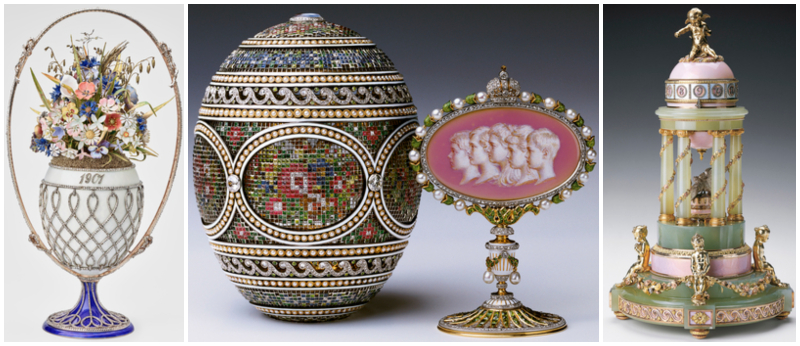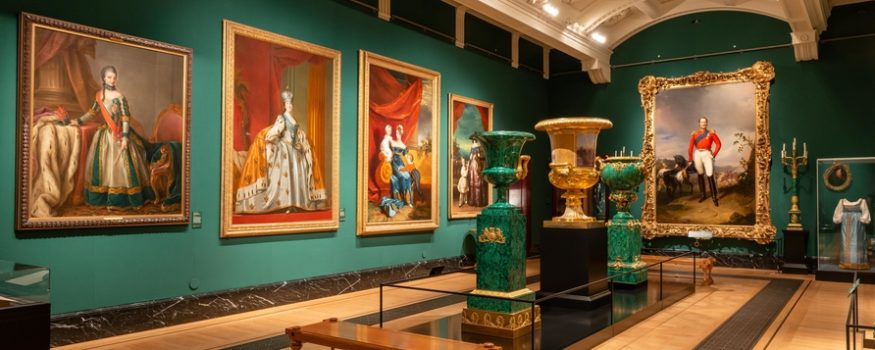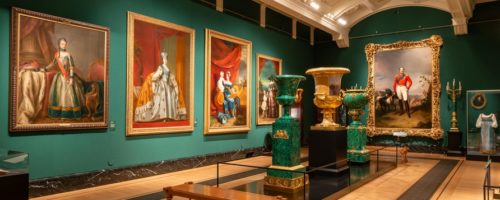Royal Collection Trust/ © Her Majesty Queen Elizabeth II 2018
A fashionable Russian-style dress worn by Princess Charlotte, daughter of George IV; three of Fabergé’s celebrated Imperial Easter eggs; and some of the earliest-known photographs of Moscow and St Petersburg are among almost 300 works in the new exhibition Russia: Royalty & the Romanovs at The Queen’s Gallery, Buckingham Palace.
Examining familial and diplomatic links between Britain and Russia and their royal houses over a period of 300 years, Russia: Royalty & the Romanovs is the first exhibition from the Royal Collection to explore these historic links through decorative arts, paintings, jewellery, costume, books, letters and photographs, many of which are on public display for the first time.
Running until 28 April 2019, visitors can see Russian-inspired clothing – thought to have gained popularity following a visit by Emperor Alexander I in 1814 – including a dress belonging to Princess Charlotte, daughter of George IV. The dress features a drawstring waist to accommodate her pregnancy and was worn for her 1817 portrait by George Dawe. Princess Charlotte died during childbirth and was widely mourned by the British public; her dress is thought to have survived as it was particularly treasured in the tragic circumstances.
Works by Carl Fabergé illustrate the shared patronage of the renowned jewellery house by the British and Russian royal families in the early 20th century, when pieces were often exchanged as gifts. The most significant additions to the group of Fabergé in the Royal Collection were made by King George V and Queen Mary, who purchased the Basket of Flowers, Colonnade and Mosaic Eggs in the 1930s. The eggs were originally commissioned by Nicholas II, the last Emperor of Russia, for his wife Alexandra Feodorovna.

Royal Collection Trust/ © Her Majesty Queen Elizabeth II 2018
The Mosaic Egg is one of the most technically sophisticated of all Fabergé’s creations. The ‘shell’ is made from a platinum mesh into which tiny diamonds, rubies, topaz, sapphires, garnets, pearls and emeralds fit to form a floral motif. Within the egg sits a ‘surprise’ – a medallion painted with the portraits of the five children of Nicholas and Alexandra. Visitors can also see an Elephant Automaton, recently discovered to be the missing surprise from the Diamond Trellis Egg.
The exhibition also includes Nicholas I’s vast portrait of himself dressed in the uniform of the Russian Cavalier Guard, which was commissioned as gift for Queen Victoria after his visit in 1844. At almost three-and-a-half meters tall, the painting is set within a highly ornate frame with a Russian imperial eagle at each corner. Another painting two year later by Franz Xaver Winterhalter shows the young Queen Victoria and the Prince of Wales, five-year-old ‘Bertie’ wearing a loose-fitting overshirt, described as his ‘Russian dress’, which is thought to have been a gift from the Emperor during his visit. Winterhalter later painted Grand Duchess Alexandra Iosifovna of Russia, sister-in-law of Alexander II and great grandmother of the Duke of Edinburgh. The portrait hung in the Marble Palace in St Petersburg in the early 20th century and was bequeathed to the Queen in 2016 for the Royal Collection by Jane, Lady Abdy from the collection of her late husband Sir Robert Abdy.
Visitors can also see some of the earliest-known photographs of Moscow and St Petersburg, taken by Irish Corporal James Mack during a visit by Lord Granville to attend the coronation of Alexander II at the Kremlin as Queen Victoria’s representative. Mack accompanied Lord Granville to make a photographic record of the places visited by the diplomatic party during their stay in Russia. The images were shown in the first exhibition of the Photographic Society of Scotland in 1856 at the request of the Society’s Patron, Prince Albert.










